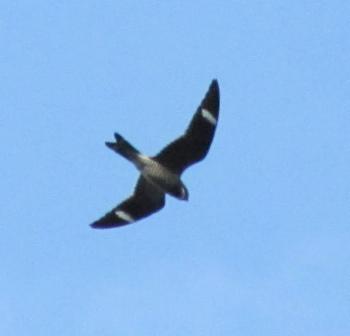Count a goatsucker
It’s that time of year again, when common nighthawks are migrating. As their name suggests, they look very hawk-like (actually, more falcon-like because of their long, pointed wings) and they tend to come out only at dusk.
But in reality, common nighthawks are actually close relations to the whip-poor-will and other members of the so-called goatsucker family. That unusual family name came from the old folk legend that these birds, with their very wide mouths, suckled on goat udders. They don’t, of course, but they are nonetheless very mysterious birds that are often poorly studied because of their nocturnal ways.
This year, many people have been reporting on the Maine birds listserve website that they believe they are seeing fewer common nighthawks than in past years. These observations raise some interesting questions. Are nighthawk populations across North America down in numbers from past years? Maybe it’s just that eastern populations are down? Are nighthawk populations the same but fewer of them are migrating though Maine (and more elsewhere)? Did nighthawks have a poor breeding season, resulting in fewer young birds passing through? Are they migrating later, such that we may not yet have seen the bulk of the numbers yet? Are there in reality the same numbers of birds, but observers are not in the right place at the right time to see them?
Understanding the state of health of a bird population based on a few anecdotal observations is a bit like trying to know the state of the economy by stopping by a couple of stores and seeing how many customers are spending money. Obviously, that’s no way to accurately predict much of anything!
To know whether common nighthawk populations are lower this year than in past years will require comparing standardized counts done over many years along with the examination of very large numbers of incidental observations from birders that are collected in massive “citizen-science” databases.
The more people that keep track of their bird sightings over the years and add them to the historical database, the more likely scientists will be able to detect changes in bird populations.
One of the easiest ways for people to contribute is through the online eBird project that allows anyone to submit any bird sightings of any kind.
We were at the Cornell Lab of Ornithology and Audubon when the idea of eBird was dreamed up, and we were part of the team that brought it to reality in 2002.
Now eBird holds nearly 200 million records, stored online and is one of the world’s foremost “citizen science” projects. Along with the Christmas Bird Count, Breeding Bird Survey, Great Backyard Bird Count, and others, eBird is helping to take those individual observations from our backyards and favorite birding areas and amalgamate them together so that we can learn more about the state of our bird populations.
So keep an eye out for common nighthawks and if you do see some, report your sighting to www.eBird.org. And check the eBird database yourself to see where, when, and how many common nighthawks are being reported across North America.





























